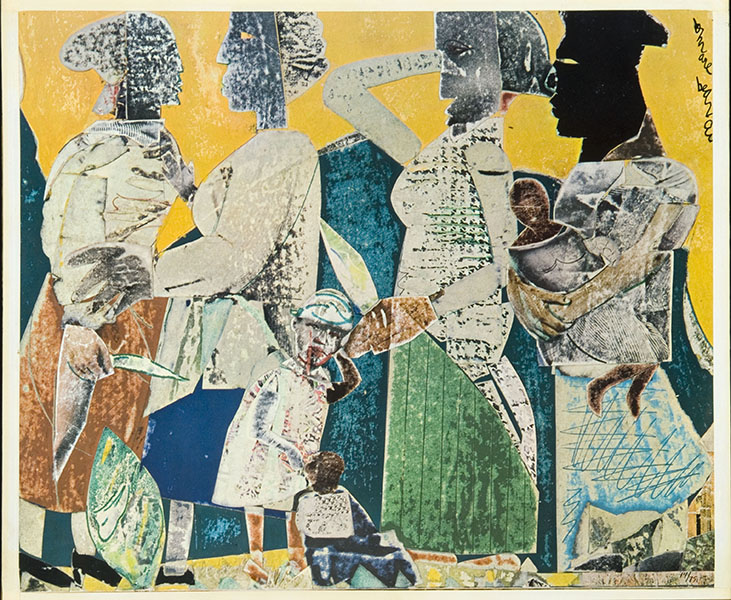
Romare Howard Bearden
American (Charlotte, North Carolina, United States, 1911 – 1988), Byzantine Frieze (from the series Ritual Bayou), 1971, lithograph collage, 17 7/8 x 21 1/4 in. Gift of Mr. and Mrs. Robert L. Gardner, 1983.34.2 © 2020 Romare Bearden Foundation / Licensed by VAGA at Artists Rights Society (ARS), NY
This week’s Image of the Week is Byzantine Frieze, one of the six lithographs from American artist Romare Bearden’s Ritual Bayou series. Bearden had a solid reputation as a painter from the 1930s to the 1960s, but his career really took off when, in the early 1960s, he began to experiment with collage. Bearden, who moved from Charlotte, North Carolina to Harlem with his parents when he was very young, had always gained inspiration from Black life and culture. In 1963 he joined a group of other African American artists in New York to form Spiral, an informal organization dedicated to discussing art, politics, and Civil Rights from the perspective of Black artists. Bearden brought with him to a meeting of the group a collection of clippings he had made from his wife’s magazines, intending to use them in a collaborative collage that would comment on the issues they were discussing at meetings. The other members weren’t interested, but Bearden began to experiment with the clippings on his own, blending them with paint, gouache, and other materials to create densely layered compositions.
From the beginning, Bearden was interested in the reproductive possibilities of his collages, exhibiting them in 1964 as a series of Projections, large-scale reproductions made with a photostat machine. They caused a sensation, launching Bearden to new heights in the art world, culminating in a one-man show at the Museum of Modern art in 1971. That show was entitled The Prevalence of Ritual, and featured collages based on Black life in the South, including many that would form the basis for works in the Ritual Bayou series. Starting in the early 1970s Bearden became interested in printmaking, and he began to work with Shorewood Studios and other printers to make works that would enable people of relatively modest means to own his work. Ritual Bayou was intended as the first set in an intended eighteen-print Portfolio, though Bearden’s process proved too laborious, and he eventually moved on to other projects.
Byzantine Frieze is particularly interesting, because it highlights one of the most striking aspects of Bearden’s work. At the Art Students League in the 1930s, Bearden had studied with the German-American painter George Grosz, one of the foremost participants in the neue Sachlichkeit (New Objectivity) movements of interwar Germany. Grosz and his colleagues were pioneers of socially conscious art, which was also dominant in the United States during the Great Depression. Bearden long believed, however, that Grosz’s most important contribution to his development as an artist was his emphasis on art history. In between painting demonstrations Grosz showed his students slides of works from the Renaissance to more recent times, and Bearden always returned to Old Masters such as Johannes Vermeer as well as more recent artists, including Pablo Picasso and Hannah Höch. In Byzantine Frieze he combines all of these interests, presenting his images of Black women and children in a flat, orderly procession reminiscent of the mosaics of the Roman Empire. The combination of the strong figures of the women with knives, blood, and other hints of violence demonstrates Bearden’s commitment to showing both the triumphs and tribulations of the African American experience, always with his eye to the history of art.
Grant Hamming, Ph.D.
American Art Research Fellow
To learn more about this work by Romare Bearden, visit our Collection page.
